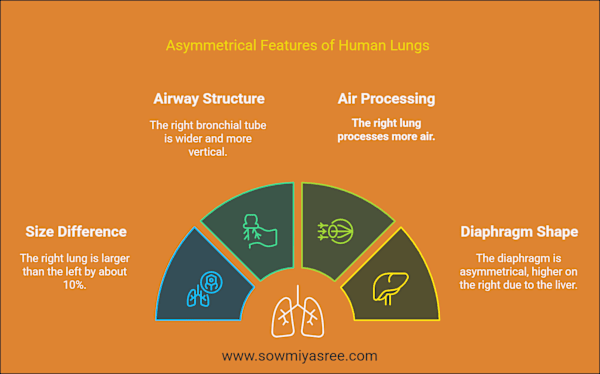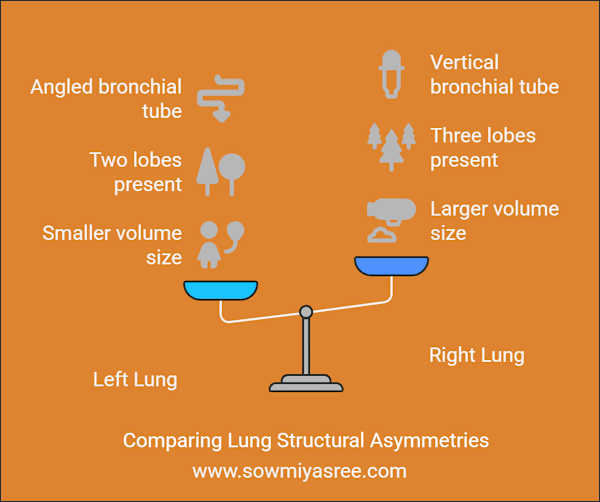id you know your lungs aren’t identical twins but have a deliberate asymmetrical design that optimizes your breathing? While appearing similar externally, your right lung has three lobes, while your left has only two. This lung asymmetry is one of your body’s most intelligent adaptations—creating perfect harmony between your respiratory and cardiovascular systems.
⏱️Estimated reading time: 5 min
🗝️Key Takeaways About Lung Asymmetry
- Your right lung has three lobes, while your left has only two, creating natural asymmetry.
- This design efficiently accommodates your heart on the left side of your chest.
- Lung asymmetry optimizes breathing function despite space constraints
- Understanding your natural lung differences can improve breathing practices
- This asymmetrical design is present from birth and normal in all humans
📋Table of Contents
Right vs. Left Lung Asymmetry: The Anatomical Differences
The Science Behind Asymmetrical Lung Design: 4 Key Differences
The Invisible Efficiency of Asymmetrical Breathing
When You Might Notice Your Lung Asymmetry
Lung Asymmetry by the Numbers
Embrace Your Body’s Brilliant Design
Experience Your Breathing: Symmetry in Asymmetry
7 Frequently Asked Questions About Lung Asymmetry
Scientific Research and Studies on Lung Asymmetry
⇄Right vs. Left Lung Asymmetry: The Anatomical Differences
Your right lung has THREE lobes, while your left has only TWO. This isn’t an accident or flaw—it’s a deliberate feature of human design! Why the difference? Your heart needs space to do its job. The left lung sacrifices a lobe to accommodate your heart, which sits slightly to the left in your chest. This natural asymmetry creates unique breathing habits that you can discover through conscious breath awareness.
Have you ever noticed that most people place their hand over the left side of their chest during national anthems? That’s where we feel our heartbeat most strongly—right where that missing lung lobe would be!
This natural asymmetry isn’t just a random quirk—it’s a testament to your body’s brilliant efficiency. Your breathing system has evolved over millions of years to optimize function while accommodating all your vital organs in limited chest space.
🧪The Science Behind Asymmetrical Lung Design: 4 Key Differences
Your asymmetrical lung design creates several fascinating differences that optimize your breathing function:
- Size difference: Your right lung is about 10% larger in volume than your left
- Airway structure: The right bronchial tube is wider and more vertical than the left
- Air processing: The right lung processes more air, creating a naturally uneven airflow
- Diaphragm shape: Your diaphragm is even asymmetrical, higher on the right side due to your liver
This strategic imbalance optimizes space in your chest cavity like a perfectly packed suitcase where everything fits just right! The exact arrangement allows your heart, lungs, and other organs to coexist in harmony while establishing the breath-energy connection many people tap into for boosting their natural vitality.
Let’s explore how this clever design impacts your everyday breathing experience.
🔎The Invisible Efficiency of Asymmetrical Breathing
Here’s what makes this even more fascinating: Despite this significant internal difference, your breathing appears perfectly balanced from the outside. Your ribcage moves evenly, and you’d never notice this asymmetry without medical imaging.
It’s one of the body’s hidden efficiencies—working differently on each side but creating a seamless breathing experience. Think of it like rowing a boat with oars of slightly different lengths—yet somehow maintaining a perfectly straight course!
This invisible efficiency highlights how evolution has perfected our respiratory system over time. Your body doesn’t waste energy on perfect symmetry—instead, it optimizes for function and performance.
🫁When You Might Notice Your Lung Asymmetry
While we don’t typically feel our lung asymmetry during normal breathing, certain situations can make it more apparent:
- During respiratory infections, congestion may affect one side more than the other
- Athletes in training sometimes develop better awareness of small breathing differences
- Some yoga and pranayama practices can increase sensitivity to these internal patterns
- Deep breathing exercises might reveal subtle differences in air capacity between sides
Many people first notice these differences when exploring activity-specific breathing patterns designed to optimize their performance in sports or exercise.
Now that you understand when you might notice these differences, let’s look at practical applications of this knowledge.
📊Lung Asymmetry by the Numbers
10-12%: The average volume difference between your larger right lung and smaller left lung
3 vs. 2: Lobe count difference between right and left lungs
25-30°: The more vertical angle of the right bronchial tube compared to the left
55%: Approximate percentage of total air processed by the right lung during normal breathing
1-2 cm: Average height difference in diaphragm position (higher on the right side)
🎨Embrace Your Body’s Brilliant Design
We’ve journeyed through the fascinating world of lung asymmetry—from understanding why your right lung has three lobes while your left has only two to discovering how this clever arrangement optimizes your breathing efficiency.
This hidden asymmetry isn’t just a quirky fact—it’s key to your body’s efficiency. By making space for the heart and optimizing airflow, your lungs work smarter, not harder, keeping you breathing effortlessly every day.
The next time you take a deep breath, remember the brilliant asymmetrical design working invisibly to support you.
🥳Experience Your Breathing: Symmetry in Asymmetry
Now that you understand the asymmetrical structure of your lungs, try this simple awareness exercise:
1. Place your right hand on your right chest and your left hand on your left chest
2. Take 5 slow, deep breaths while noticing how evenly your ribcage expands on both sides
3. Reflect on how your body coordinates this symmetrical movement despite having lungs with different internal structures
This experience highlights an impressive feature of your respiratory system: despite having structurally different lungs internally, your body creates balanced, coordinated movement during breathing. It’s a perfect example of how function doesn’t always require symmetrical structure!
Have you ever thought about this remarkable coordination before? Share your thoughts in the comments below!
❓7 Frequently Asked Questions About Lung Asymmetry
Is lung asymmetry normal or a medical concern?
Lung asymmetry is completely normal and present in everyone. The difference in lobes (three on the right, two on the left) is a standard feature of human anatomy designed to accommodate your heart, not a medical condition.
Can lung asymmetry affect my breathing capacity?
Despite having asymmetrical lungs, your overall breathing capacity remains optimal. Your body has evolved this design specifically to maximize breathing efficiency while making room for other vital organs.
Why do some breathing techniques feel harder on one side?
Due to the different structure of each lung, certain breathing techniques might highlight these natural differences. This doesn’t indicate a problem—just your increased awareness of your natural anatomy.
Can I balance out my lung asymmetry through exercise?
You can’t and shouldn’t try to change your anatomical asymmetry. However, breathing exercises can help you become more aware of your natural patterns and work with them more effectively.
Does lung asymmetry contribute to snoring or sleep apnea?
Basic lung asymmetry itself doesn’t cause these conditions. However, understanding your natural asymmetry might help explain why certain sleeping positions feel more comfortable than others.
Are children’s lungs asymmetrical too, or does this develop with age?
Children are born with asymmetrical lungs—it’s a fundamental feature of human anatomy present from birth, not something that develops over time.
How does lung asymmetry relate to heart health?
The asymmetry specifically accommodates your heart’s position. This clever arrangement ensures your heart has adequate space to function properly while maximizing breathing capacity.
🔬Scientific Research and Studies on Lung Asymmetry
- Tomioka, H., Amimoto, H., Fujii, H., Katsuyama, E., Okuno, T., & Kawabata, Y. (2020). Asymmetrical Interstitial Lung Disease Suggested to Be Due to Hypoplasia of the Unilateral Pulmonary Artery: A Case Report with a 20-year Follow-up. Internal Medicine, 60(8), 1265. https://doi.org/10.2169/internalmedicine.5753-20
- Kundu, D., & Panchagnula, M. V. (2023). Asymmetric lung increases particle filtration by deposition. Scientific Reports, 13(1). https://doi.org/10.1038/s41598-023-36176-3
- The Lungs | Anatomy and Physiology II. (n.d.). https://courses.lumenlearning.com/suny-ap2/chapter/the-lungs/
- Fleming, J., Conway, J., Majoral, C., Bennett, M., Caillibotte, G., Montesantos, S., & Katz, I. (2014). Determination of regional lung air volume distribution at mid-tidal breathing from computed tomography: A retrospective study of normal variability and reproducibility. BMC Medical Imaging, 14, 25. https://doi.org/10.1186/1471-2342-14-25
- Kwon, J., Cook-Jong Lee, J., & Moon, J. (2019). Diagnostic significance of diaphragmatic height index in traumatic diaphragmatic rupture. Annals of Surgical Treatment and Research, 97(1), 36. https://doi.org/10.4174/astr.2019.97.1.36
🪶Written by Sowmiya Sree | Breath Researcher & Author on a series of topics related to Breath
This article is thoroughly researched and fact-checked using peer-reviewed studies and trusted medical resources. Last updated: March 2025
Note: This article is for informational purposes only and does not constitute medical advice. Always consult your healthcare provider for medical concerns.


